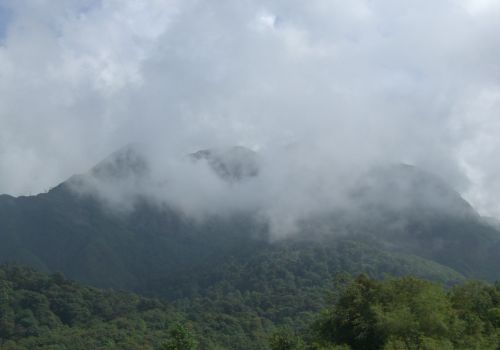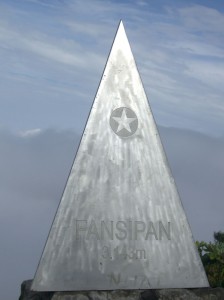-

Here’s a little report on how to climb Fansipan in two days. I’m leaving it here for anyone to read: hopefully it can help a prospective hiker to decide if the hike is something you may want to do.
Originally, we signed on for a three day excursion. Halfway through the first day we decided that we felt strong enough to do it all in two days – a good decision, as it turned out. We did the trek together with a guide and one porter. The porter carried most of the supplies, excluding personal items and water. He also cooked our meals. The guide walked with us, pointing out a few niceties along the route as well as handling the permits and paperwork. I guess that we could have done without a guide, but he did make our lives easier. He also scared away a few snakes that were sunning themselves on the trail, so maybe he did earn his keep after all.
Fitness Level
You have to be reasonably fit to do it in three days. To do it in two days takes a bit more, but it is within range for most people with the desire to do it. We encountered three guys in their late sixties doing the trek – granted they were tough as guts though. We also met a young guy doing it in one day, but that might take a pretty athletic person. Us? Jaime runs a marathon in 4:20. I’m not as fit, but my body is pretty much built for hiking, since I’m tall and skinny and stubborn (built for hiking and darts. That’s all I’m afraid).
What to Bring
You’ll need a raincoat, as the upper part of the hike is very wet. Much of the trail is muddy, and there are a few streams to cross, so bring good footwear too. Unless you plan on doing the whole hike in one day, you’ll need warm clothes for the night. Don’t underestimate how cold it gets up there: even though your guide may set you up with a sleeping bag, you still want to have thermal underwear, a thick fleece and socks, at least. We brought 1.5 liters of water each, which was enough for the first day. The second day we refilled our bottles at a stream at base camp, using iodine purification tablets to make sure we didn’t pick up anything nasty. It’s also nice to bring a chocolate bar and some fruit to snack on during breathers.
Day One
The hike begins at a national park office building – your last chance to use a WC facility for a while. The first part of the hike is relatively easy, taking you on a path through fairly open rain forest. You have to cross a few small streams and rivulets. After approximately two hours on this trail you will reach the first camp – a tarp-covered hut that sells water and a few other basic necessities. The prices are high but not unreasonable. We had our lunch here: bread, cheese, fruit and eggs.
After the meal, the hike continues along the same path. Parts of the trail follow a small dried-out stream, while other parts are far more wet and muddy. After a little while, you will notice that the forest clears up a bit. We were told that the forest burned down in 1986. You will continue through this type of landscape for a fair while, going up and down along a brushy ridge.
The trail gets a bit rougher here, as it climbs steadily upwards. A concrete handrail has been set up to help you along, as well as a few strategically placed metal ladders. Some moderate scrambling can be necessary, as you go up and down a few gorges. It’s not difficult, but it does sap your strength.
By now, the brush will give way to dense rain forest. The trail goes up and down, and low-hanging vines and bamboo will give you something to grab onto as you climb further on. Gradually, the trees are replaced by bamboo groves. At times, you will be rewarded with spectacular views of the surrounding areas, unless of course the clouds makes it impossible to see anything. After a while, you will reach base camp, which sits at an altitude of 2800 meters.
We started our hike at ten o’clock in the morning and ended at base camp at three thirty, with a one hour break for lunch. The facilities at base camp are very basic: you sleep on bamboo platforms inside a corrugated iron hut. Some ways off, a hole in the ground surrounded by tarp provides a ‘restroom’. Our porter did a fantastic job for us that night, cooking up a six-course dinner that we washed down with a few shots of rice wine.
Day Two
It got very cold at night, and we did not catch much sleep. We rose at five thirty, and had a basic breakfast of instant noodles and coffee. We set out for the summit at seven o clock.
The next part of the hike looks very much like the end of day one – a muddy, rocky trail surrounded by dense bamboo groves. The trail goes up and down along the mountainside, and after about an hour you reach the beginning of the last push. If you are lucky, you can see Sapa town below you. However, the upper parts of Fansipan is more often than not sitting inside a cloud bank. The last thirty minutes you hike steadily upwards towards the peak.
We summited at 9:35 am. The clouds around us were dense, but luck had it that they cleared up for a while in each direction. We got a good view of Sapa town on one side, and far-away China on the other. Needless to say, it was very rewarding to sit there and share a chocolate bar, take a few pictures and chat about the hike.

The Descent
Save some energy for the way down, since it does have some pretty exhausting parts. We began our descent at ten o’clock, and reached the finish at three fifteen. Sore, but happy. All in all it was a great experience. It comes with our wholehearted recommendations!
No related posts.
Related posts brought to you by Yet Another Related Posts Plugin.
This entry was posted on Sunday, June 14th, 2009 at 1:07 am and is filed under Vietnam. You can follow any responses to this entry through the RSS 2.0 feed. You can leave a response, or trackback from your own site.
-
http://www.muscle-tec.com/cart.php?action=add&product_id=201 Benefits Of Acai














